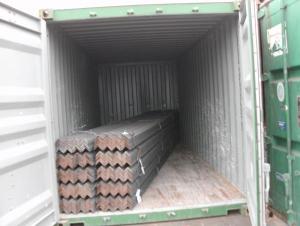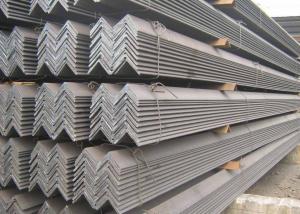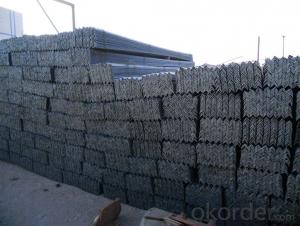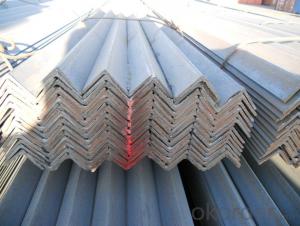JIS Equal Angle Steel Angles
- Loading Port:
- China Main Port
- Payment Terms:
- TT or L/C
- Min Order Qty:
- 25 m.t.
- Supply Capability:
- 1000 m.t./month
OKorder Service Pledge
OKorder Financial Service
You Might Also Like
Specifications of JIS Equal Angle
1.Standards:GB,ASTM,BS,AISI,DIN,JIS
2.Length:6m,9m,12m
3.Material:GBQ235B,Q345BorEquivalent;ASTMA36;EN10025,S235JR,S355JR;JISG3192,SS400;SS540.
4. Payment terms:
1).100% irrevocable L/C at sight.
2).30% T/T prepaid and the balance against the copy of B/L.
3).30% T/T prepaid and the balance against L/C
5.Sizes:
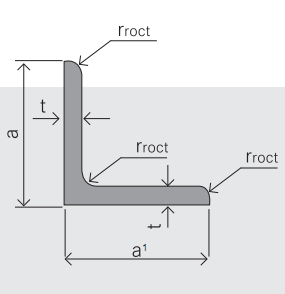
EQUAL ANGLES SIZES |
| ||
a(mm) | a1(mm) | thickness(mm) | length |
25 | 25 | 2.5---3.0 | 6M/12M |
30 | 30 | 2.5---4.0 | 6M/12M |
38 | 38 | 2.5 | 6M/12M |
38 | 38 | 3.0---5.0 | 6M/12M |
40 | 40 | 3.0---6.0 | 6M/12M |
50 | 50 | 3 | 6M/12M |
50 | 50 | 3.7---6.0 | 6M/9M/12M |
60 | 60 | 5.0---6.0 | 6M/9M/12M |
63 | 63 | 6.0---8.0 | 6M/9M/12M |
65 | 65 | 5.0---8.0 | 6M/9M/12M |
70 | 70 | 6.0---7.0 | 6M/9M/12M |
75 | 75 | 5.0---10.0 | 6M/9M/12M |
80 | 80 | 6.0---10.0 | 6M/9M/12M |
90 | 90 | 6.0---10.0 | 6M/9M/12M |
100 | 100 | 6.0---12.0 | 6M/9M/12M |
120 | 120 | 8.0-12.0 | 6M/9M/12M |
125 | 125 | 8.0---12.0 | 6M/9M/12M |
130 | 130 | 9.0-12.0 | 6M/9M/12M |
140 | 140 | 10.0-16.0 | 6M/9M/12M |
150 | 150 | 10---15 | 6M/9M/12M |
160 | 160 | 10---16 | 6M/9M/12M |
180 | 180 | 12---18 | 6M/9M/12M |
200 | 200 | 14---20 | 6M/9M/12M |
6. Material details:
Grade | Yield Strength,N/mm² | Extension Strength N/mm² | |||
Thickness of Steel,mm | |||||
≦16 | >16-≦40 | >40-≦100 | >100 | ||
SS330 | ≧205 | ≧195 | ≧175 | ≧165 | 330-430 |
SS400 | ≧245 | ≧235 | ≧215 | ≧205 | 400-510 |
SS490 | ≧285 | ≧275 | ≧255 | ≧245 | 490-610 |
SS540 | ≧400 | ≧390 | - | - | ≧540 |
Usage & Applications of JIS Equal Angle
Trusses;
Transmission towers;
Telecommunication towers;
Bracing for general structures;
Stiffeners in structural use.
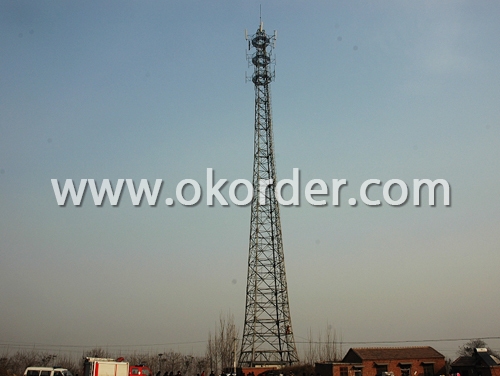
Packaging & Delivery of JIS Equal Angle
1. Transportation: the goods are delivered by truck from mill to loading port, the maximum quantity can be loaded is around 40MTs by each truck. If the order quantity cannot reach the full truck loaded, the transportation cost per ton will be little higher than full load.
2. With bundles and load in 20 feet/40 feet container, or by bulk cargo, also we could do as customer's request.
3. Marks:
Color mark: There will be color marking on both end of the bundle for the cargo delivered by bulk vessel. That makes it easily to distinguish at the destination port.
Tag mark: There will be tag mark tied up on the bundles. The information usually including supplier logo and name, product name, made in China, shipping marks and other information request by the customer.
If loading by container the marking is not needed, but we will prepare it as customer request.

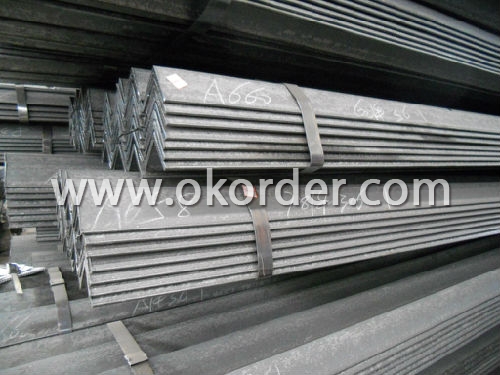
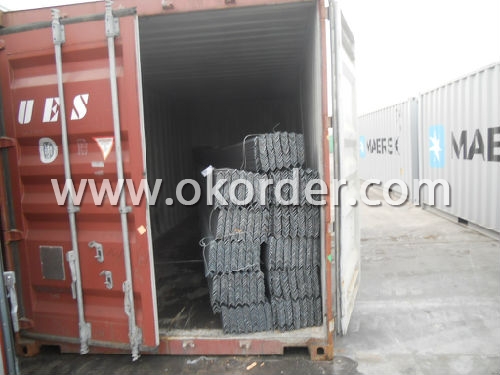
- Q:Can steel angles be used in mining or quarrying machinery?
- Steel angles are indeed applicable in mining or quarrying machinery. They offer structural support and reinforcement to different machinery components used in these sectors. Frames, supports, and brackets for equipment like crushers, conveyors, and screens are often constructed using steel angles. Due to their high strength and durability, steel angles can withstand the heavy loads, vibrations, and harsh operating conditions commonly experienced in mining or quarrying operations. Moreover, steel angles can be easily fabricated and welded to meet specific design needs, making them a flexible option for machinery applications in these industries.
- Q:How do you calculate the stability factor of a steel angle?
- The stability factor of a steel angle is calculated by dividing the Euler buckling load by the applied compressive load.
- Q:What are the common defects or issues found in steel angles?
- Some common defects or issues found in steel angles include surface imperfections such as cracks, scratches, or dents, dimensional variations such as uneven or inconsistent lengths, widths, or thicknesses, and improper alignment or straightness. Other issues can include corrosion, rusting, or lack of proper coating, as well as inadequate welding or joining, leading to weak or compromised structural integrity.
- Q:Can steel angles be used in agricultural buildings?
- Yes, steel angles can be used in agricultural buildings. Steel angles are commonly used in construction due to their durability and structural strength. They can be used for framing, bracing, and reinforcing various parts of agricultural buildings such as roofs, walls, and support structures. Steel angles provide stability and resistance against external forces, making them suitable for the demanding environments often found in agricultural settings.
- Q:What are the different methods for strengthening steel angles?
- There are several methods for strengthening steel angles, depending on the specific requirements and intended applications. Here are some of the common methods: 1. Heat treatment: One of the most common methods for strengthening steel angles is through heat treatment processes such as quenching and tempering. Quenching involves rapidly cooling the steel angle after heating it to a high temperature, which increases its hardness and strength. Tempering, on the other hand, involves reheating the quenched steel angle to a lower temperature, which reduces its brittleness and improves its toughness. 2. Alloying: By adding certain alloying elements such as chromium, molybdenum, or nickel, the strength and hardness of steel angles can be significantly increased. These alloying elements form solid solutions with the iron matrix, resulting in improved mechanical properties and resistance to wear or corrosion. 3. Cold working: Cold working processes like cold rolling, cold drawing, or cold forming can enhance the strength and hardness of steel angles. These processes involve deforming the steel angle at room temperature, which causes dislocations in the crystal structure and increases its strength. 4. Welding: Welding techniques such as fusion welding or spot welding can be utilized to strengthen steel angles by joining them with other steel components. The weld joint can often provide additional strength and rigidity to the steel angle structure. 5. Surface treatments: Applying various surface treatments like galvanizing, powder coating, or painting can improve the corrosion resistance of steel angles, thereby increasing their longevity and overall strength. It is important to note that the choice of method for strengthening steel angles depends on factors such as the specific grade of steel, intended application, and desired mechanical properties. Consulting with a professional engineer or metallurgist is recommended to determine the most suitable method for a particular scenario.
- Q:Are steel angles suitable for window frames?
- Yes, steel angles are suitable for window frames. Steel angles are often used in construction for their strength and durability, making them an ideal choice for supporting the weight of window frames. They provide excellent structural support, ensuring that the window frames remain stable and secure. Additionally, steel angles are resistant to corrosion, which is particularly advantageous for window frames that are exposed to external elements such as rain and humidity. Furthermore, steel angles can be easily fabricated and customized to meet specific design requirements, making them a versatile option for window frame construction. Overall, steel angles offer numerous benefits that make them a suitable choice for window frames in terms of strength, durability, corrosion resistance, and flexibility.
- Q:What is the maximum span for a steel angle beam?
- The maximum span for a steel angle beam depends on several factors, including the size and shape of the beam, the load it is supporting, and the allowable deflection criteria. Generally, the maximum span for a steel angle beam can range from a few feet to several dozen feet. It is important to consult structural engineering codes and guidelines, as well as engage a professional engineer, to determine the specific maximum span for a steel angle beam based on the project requirements and conditions.
- Q:How do steel angles perform in terms of energy efficiency?
- Steel angles are not directly associated with energy efficiency. Energy efficiency is typically evaluated based on factors such as insulation, building design, and the use of energy-efficient appliances or systems. However, steel angles can be used in construction projects to provide structural support, which indirectly contributes to the overall energy efficiency of a building by ensuring its stability and durability.
- Q:How do you prevent galvanic corrosion in steel angles?
- To prevent galvanic corrosion in steel angles, there are a few measures that can be taken. 1. Proper coating: Applying a protective coating such as paint, epoxy, or galvanization can create a barrier between the steel angle and other metals. This prevents direct contact and minimizes the risk of galvanic corrosion. 2. Insulation: Using insulation materials such as rubber or plastic washers, gaskets, or sleeves can help isolate the steel angle from other metals. This prevents the flow of electrical currents and reduces the chances of galvanic corrosion. 3. Proper design considerations: When designing structures or systems that involve steel angles, it is important to consider the compatibility of different metals. Pairing metals with similar electrochemical properties can help minimize the risk of galvanic corrosion. 4. Regular maintenance: Regular inspections and maintenance of steel angles can help identify and address early signs of galvanic corrosion. This includes checking for any damage to the protective coating, ensuring proper insulation, and applying appropriate remedies if corrosion is detected. By implementing these preventive measures, the risk of galvanic corrosion in steel angles can be significantly reduced, ensuring their longevity and structural integrity.
- Q:Can steel angles be used for supports in construction?
- Yes, steel angles can be used for supports in construction. Steel angles are commonly used in construction projects as structural supports due to their strength and versatility. They can be used in various applications such as supporting beams, columns, and frames. Steel angles provide stability and rigidity to the structure, making them suitable for supporting heavy loads and withstanding forces such as gravity and wind. Additionally, they can be easily welded or bolted together, allowing for quick and efficient installation. Overall, steel angles are a popular choice for construction supports due to their durability, strength, and ease of use.
1. Manufacturer Overview |
|
|---|---|
| Location | Hebei, China |
| Year Established | 2003 |
| Annual Output Value | Above US$ 500 Million |
| Main Markets | Southeast Asia; middle east; South Korea; Africa |
| Company Certifications | ISO 9001:2008 |
2. Manufacturer Certificates |
|
|---|---|
| a) Certification Name | |
| Range | |
| Reference | |
| Validity Period | |
3. Manufacturer Capability |
|
|---|---|
| a)Trade Capacity | |
| Nearest Port | Tianjin |
| Export Percentage | 30%-45% |
| No.of Employees in Trade Department | 11-20 People |
| Language Spoken: | English; Chinese |
| b)Factory Information | |
| Factory Size: | Above 10,000 square meters |
| No. of Production Lines | 2 |
| Contract Manufacturing | OEM service offered |
| Product Price Range | high; average |
Send your message to us
JIS Equal Angle Steel Angles
- Loading Port:
- China Main Port
- Payment Terms:
- TT or L/C
- Min Order Qty:
- 25 m.t.
- Supply Capability:
- 1000 m.t./month
OKorder Service Pledge
OKorder Financial Service
Similar products
New products
Hot products
Hot Searches
Related keywords
